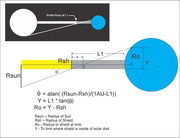Ok, I tossed the napkin but, since I was asked, here is what I think is correct.
I did confuse my shield dimension. Fortunately it seems to actually be 1/2 of the value I gave earlier. This shield array diameter is 1225 km.
The first image shows what that shield would look like to scale when viewing the Sun's white disk.
The radiation from the center of the Sun, surprisingly, is about 2.6x that of the radiation coming from the limb of the Sun. This is known as the CLV - center to limb variation. So, the shield will be blocking more of the more intense radiation, which I took into rough consideration to get to that 1% value in the prior post. This central zone radiation blockage applies to 0.92% of the Earth's cross-section.
But, moving out along the Earth's surface, how far would one go where the shield's disk would appear outside the solar disk, one should ask. Surprisingly, at the 1225km dia. for the shield disk, it would block about 0.8% all over the Earth.
Things like Earth's curvature, Earth's radial distance to surface, etc. were ignored. All is based on cross-sectional values, which should make very little difference, except for the amount of math necessary to tweak it a tiny bit.
Note: I see the third image has the Excel work where the right page should be on the left. [I use green highlighted cells as the input variable, and yellow highlight for results. Thus, if you have a preferred shield size, it is no problem getting instant results.]









